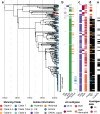Emergence and divergence of major lineages of Shiga-toxin-producing Escherichia coli in Australia
- PMID: 31107203
- PMCID: PMC6562248
- DOI: 10.1099/mgen.0.000268
Emergence and divergence of major lineages of Shiga-toxin-producing Escherichia coli in Australia
Abstract
Shiga-toxin-producing Escherichia coli (STEC) infection is an important global cause of foodborne disease. To date however, genomics-based studies of STEC have been predominately focused upon STEC collected in the Northern Hemisphere. Here, we demonstrate the population structure of 485 STEC isolates in Australia, and show that several clonal groups (CGs) common to Australia were infrequently detected in a representative selection of contemporary STEC genomes from around the globe. Further, phylogenetic analysis demonstrated that lineage II of the global O157:H7 STEC was most prevalent in Australia, and was characterized by a frameshift mutation in flgF, resulting in the H-non-motile phenotype. Strong concordance between in silico and phenotypic serotyping was observed, along with concordance between in silico and conventional detection of stx genes. These data represent the most comprehensive STEC analysis from the Southern Hemisphere, and provide a framework for future national genomics-based surveillance of STEC in Australia.
Keywords: STEC; enteric pathogens; epidemiology; evolution; genomic epidemiology.
Conflict of interest statement
The authors declare that there are no conflicts of interest.
Figures



Similar articles
-
Molecular Prediction of the O157:H-Negative Phenotype Prevalent in Australian Shiga Toxin-Producing Escherichia coli Cases Improves Concordance of In Silico Serotyping with Phenotypic Motility.J Clin Microbiol. 2018 Mar 26;56(4):e01906-17. doi: 10.1128/JCM.01906-17. Print 2018 Apr. J Clin Microbiol. 2018. PMID: 29367299 Free PMC article.
-
Virulence genes, Shiga toxin subtypes, major O-serogroups, and phylogenetic background of Shiga toxin-producing Escherichia coli strains isolated from cattle in Iran.Microb Pathog. 2017 Aug;109:274-279. doi: 10.1016/j.micpath.2017.05.041. Epub 2017 May 31. Microb Pathog. 2017. PMID: 28578089
-
Molecular characterization and phylogeny of Shiga toxin-producing Escherichia coli isolates obtained from two Dutch regions using whole genome sequencing.Clin Microbiol Infect. 2016 Jul;22(7):642.e1-9. doi: 10.1016/j.cmi.2016.03.028. Epub 2016 Apr 4. Clin Microbiol Infect. 2016. PMID: 27058887
-
Taxonomy Meets Public Health: The Case of Shiga Toxin-Producing Escherichia coli.Microbiol Spectr. 2014 Jun;2(3). doi: 10.1128/microbiolspec.EHEC-0019-2013. Microbiol Spectr. 2014. PMID: 26103973 Review.
-
Characteristics of the Shiga-toxin-producing enteroaggregative Escherichia coli O104:H4 German outbreak strain and of STEC strains isolated in Spain.Int Microbiol. 2011 Sep;14(3):121-41. doi: 10.2436/20.1501.01.142. Int Microbiol. 2011. PMID: 22101411 Review.
Cited by
-
Re-evaluation of a Neonatal Mouse Model of Infection With Enterotoxigenic Escherichia coli.Front Microbiol. 2021 Mar 18;12:651488. doi: 10.3389/fmicb.2021.651488. eCollection 2021. Front Microbiol. 2021. PMID: 33815340 Free PMC article.
-
Complete microbial genomes for public health in Australia and the Southwest Pacific.Microb Genom. 2020 Dec;6(12):mgen000471. doi: 10.1099/mgen.0.000471. Epub 2020 Nov 12. Microb Genom. 2020. PMID: 33180013 Free PMC article.
-
Validation of Core and Whole-Genome Multi-Locus Sequence Typing Schemes for Shiga-Toxin-Producing E. coli (STEC) Outbreak Detection in a National Surveillance Network, PulseNet 2.0, USA.Microorganisms. 2025 Jun 4;13(6):1310. doi: 10.3390/microorganisms13061310. Microorganisms. 2025. PMID: 40572198 Free PMC article.
-
Added Value of Genomic Surveillance of Virulence Factors in Shiga Toxin-Producing Escherichia coli in New South Wales, Australia.Front Microbiol. 2021 Dec 23;12:713724. doi: 10.3389/fmicb.2021.713724. eCollection 2021. Front Microbiol. 2021. PMID: 35002991 Free PMC article.
-
Early termination of the Shiga toxin transcript generates a regulatory small RNA.Proc Natl Acad Sci U S A. 2020 Oct 6;117(40):25055-25065. doi: 10.1073/pnas.2006730117. Epub 2020 Sep 23. Proc Natl Acad Sci U S A. 2020. PMID: 32968018 Free PMC article.
References
-
- Butcher H, Elson R, Chattaway MA, Featherstone CA, Willis C, et al. Whole genome sequencing improved case ascertainment in an outbreak of shiga toxin-producing Escherichia coli O157 associated with raw drinking milk. Epidemiol Infect. 2016;144:2812–2823. doi: 10.1017/S0950268816000509. - DOI - PMC - PubMed
Publication types
MeSH terms
Substances
LinkOut - more resources
Full Text Sources
Medical

